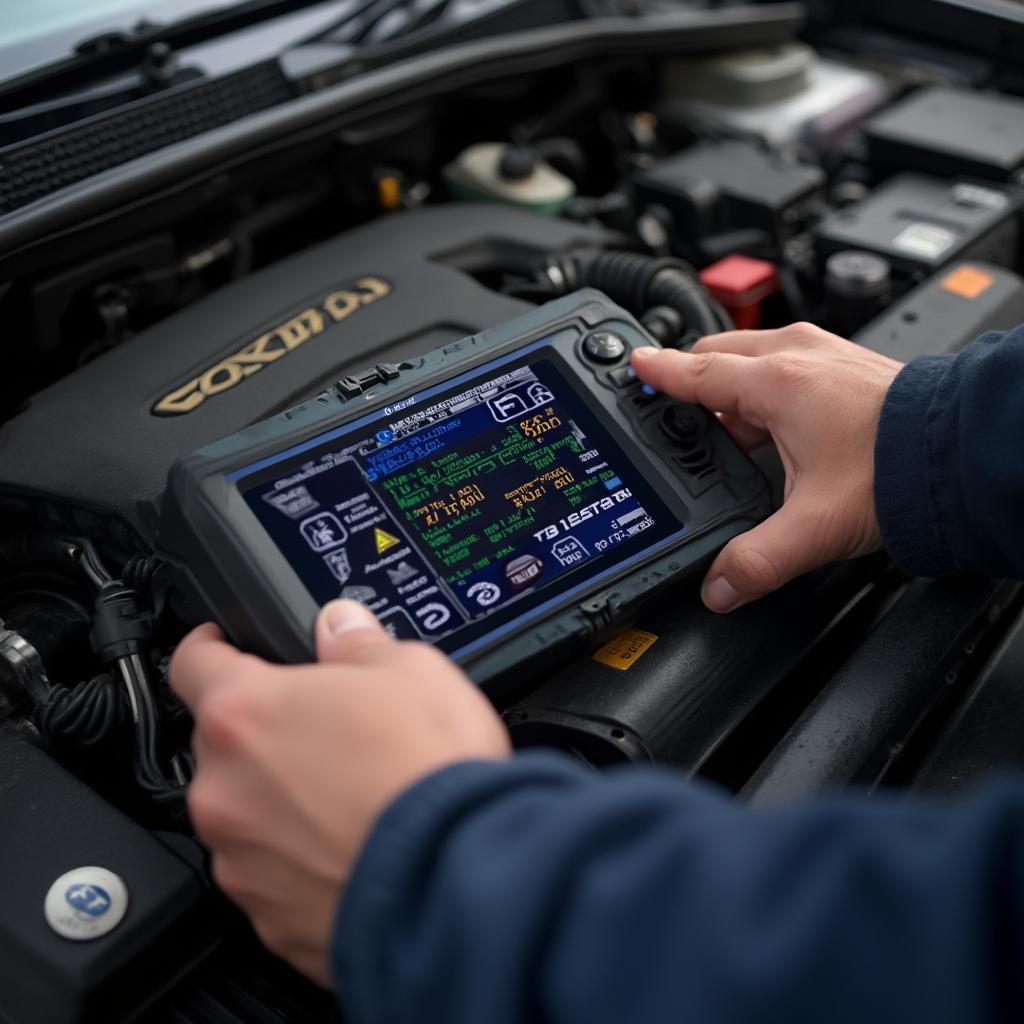Understanding Subaru diesel OBD2 codes can be crucial for maintaining your vehicle’s health and performance. Whether you’re a DIY mechanic or a seasoned professional, this guide will provide you with the knowledge you need to interpret those cryptic codes and get your Subaru back on the road. We’ll explore common issues, diagnostic procedures, and tips for preventing future problems. Let’s dive into the world of Subaru diesel diagnostics.
A quick search for an obd2 2008 compatible scanner can yield numerous results, so understanding your Subaru’s specific needs is vital. Subaru diesel engines, known for their reliability and efficiency, are also subject to the same diagnostic standards as other vehicles. The OBD2 (On-Board Diagnostics II) system acts as your car’s internal communication network, constantly monitoring various sensors and components. When a problem arises, the system generates a specific OBD2 code, providing a valuable clue to the underlying issue.
Common Subaru Diesel OBD2 Codes
Several OBD2 codes are commonly encountered in Subaru diesel vehicles. These codes can indicate problems with the emissions system, fuel system, or other crucial components. Knowing what these codes mean can save you time and money.
- P0401 (EGR Insufficient Flow): This code suggests a problem with the Exhaust Gas Recirculation (EGR) system, which helps reduce emissions. This issue might stem from a clogged EGR valve or a faulty EGR sensor.
- P0299 (Turbo Underboost): This code indicates that the turbocharger isn’t producing enough boost pressure. Possible causes include a leak in the intake system, a faulty turbocharger, or issues with the turbo control system.
- P0420 (Catalyst System Efficiency Below Threshold): This code points to a potential problem with the catalytic converter, which is responsible for converting harmful exhaust gases into less harmful substances. A failing catalytic converter can impact performance and emissions.
- P0087 (Fuel Rail/System Pressure – Too Low): This code signifies low fuel pressure, which can lead to poor performance, hard starting, and even stalling. Causes could range from a clogged fuel filter to a malfunctioning fuel pump.
Diagnosing Subaru Diesel OBD2 Codes
When faced with an OBD2 code, a systematic approach to diagnosis is essential. While an OBD2 scanner is a vital tool, it only provides the starting point. Further investigation is often necessary to pinpoint the exact cause of the problem.
- Retrieve the Codes: Start by connecting a compatible OBD2 scanner to your Subaru’s diagnostic port, usually located under the dashboard. The scanner will display the stored codes. Note down all the codes before clearing them.
- Research the Codes: Use reputable resources to understand the meaning and potential causes of each code. This information will guide your diagnostic process.
- Inspect Related Components: Based on the code description, visually inspect the relevant components. Look for obvious signs of damage, loose connections, or leaks.
- Test Components: Use a multimeter or other diagnostic tools to test the functionality of suspect components. This can help you identify the faulty part.
- Consult Service Information: Refer to your Subaru’s service manual for detailed diagnostic procedures and wiring diagrams specific to your model.
Preventing Future OBD2 Codes
Preventing OBD2 codes is always better than dealing with them after they appear. Regular maintenance and proactive care can significantly reduce the likelihood of encountering these issues.
- Regular Oil Changes: Using the correct oil and adhering to the recommended oil change intervals is crucial for engine health.
- Fuel Filter Replacement: A clogged fuel filter can lead to fuel system problems. Replace the fuel filter at the recommended intervals.
- EGR System Maintenance: Keeping the EGR system clean and functioning correctly can help prevent EGR-related codes.
- Quality Fuel: Using high-quality diesel fuel can minimize the risk of fuel system issues.
Conclusion
Understanding and addressing Subaru diesel OBD2 codes is essential for maintaining optimal performance and longevity. By utilizing the information provided in this guide, you can take a proactive approach to vehicle maintenance and ensure a smooth, efficient driving experience. Remember to consult a qualified mechanic if you encounter complex issues or require assistance with repairs. Regular maintenance and a foxwell professional automotive obd2 scanner nt624 pro can help you keep your Subaru diesel running smoothly for years to come.
FAQ
- What does OBD2 stand for? OBD2 stands for On-Board Diagnostics II.
- Where is the OBD2 port located in a Subaru? The OBD2 port is usually located under the dashboard on the driver’s side.
- Can I clear OBD2 codes myself? Yes, you can clear codes with an OBD2 scanner, but this doesn’t fix the underlying problem.
- What should I do if a code reappears after clearing it? If a code reappears, it indicates a persistent problem that needs further diagnosis.
- Are all OBD2 scanners compatible with Subaru diesel vehicles? Not all scanners are created equal. Ensure your scanner supports diesel protocols.
Do you have more questions about OBD2 and your Subaru diesel? Explore our ancel vd500 obd2 scanner car list or find more information on the fixd obd2 port and foxwell obd2 scanner software.
Need help with your Subaru diesel obd2 codes? Contact us via WhatsApp: +1(641)206-8880, Email: [email protected] or visit us at 789 Elm Street, San Francisco, CA 94102, USA. We offer 24/7 customer support.


